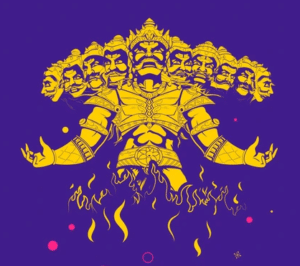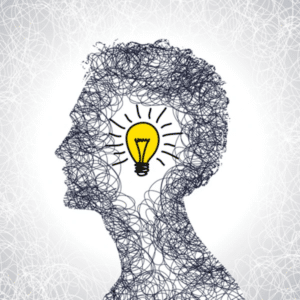Vibrant festivities mark the celebration of Navratri and Dussehra like the bursting of firecrackers, Garba dances, and the symbolic burning of Ravan’s ten-headed effigy. However beyond these festivities lies a profound spiritual lesson that transforms these rituals from mere entertainment into symbols of inner growth, that point toward a deeper underlying revelation.
 The ten heads of Ravan, the inner demons of our mind – Anger, Boredom, Comparison, Deceit, Fear, Greed, Hatred, Jealousy, Lust and at the core, Ego. These forces drive our internal conflicts. Our contrast mind, the epitome of comparison compels us to compare and we sway between dualities constantly.
The ten heads of Ravan, the inner demons of our mind – Anger, Boredom, Comparison, Deceit, Fear, Greed, Hatred, Jealousy, Lust and at the core, Ego. These forces drive our internal conflicts. Our contrast mind, the epitome of comparison compels us to compare and we sway between dualities constantly.
Hindu mythology describes the deceitful demon, Mahishasura, as half-human and half-buffalo, depicting how the contrast mind functions, dividing all our experiences into dualities. This is a reflection of our internal conflicts. Within us, there’s a righteous fighter, but there’s an unrighteous fighter too; one capable of defeating the demons, our bad tendencies, habits and wrong beliefs and the other that nurtures them all. There’s a Hans, meaning swan, which symbolizes purity, while there’s also a Kans, the villain, that embodies our devilish tendencies. There’s a Ravan, the demon, and a Ram, the Divine.
We must train our minds and gain an in-depth understanding, the Brahmastra, the ultimate weapon, which will empower us to slay and conquer the demons of the mind and embark on a path of inner peace and enlightenment.
In the realm of Hindu mythology, the transformation of Bhairavbali from a demonic enemy to a revered deity offers a profound spiritual lesson. When the demonic enemies within become our virtuous friends, it means the weapon has done its job, the battle has been won.
Bhairavbali is worshipped alongside Goddess Vaishnavi, a manifestation of the Hindu mother Goddess Lakshmi, as a combined avatar of the three Goddesses, Mahakali, Mahalakshmi, and Mahasaraswati; a creation to kill Bhairavbali, a tantric as per Hindu mythology. Although Goddess Vaishnavi slayed Bhairavbali, we yet revere him because of his death which is symbolized by his getting beheaded signifying the surrender of the ego. He realized and accepted the mistake that he committed out of his ignorance. Here, his desire to marry and unite with Goddess Vaishnavi symbolizes our mind wanting to unite with the Self. It is unaware that it needs to drop itself for true Self-realization. Bhairavbali’s transformation into a revered deity illustrates how the mind drops itself on purifying, with the understanding of the ultimate truth. At the pinnacle of Bhakti, devotion, we become ready to surrender, letting go of ego willingly. The mind that was once the source of sorrow, becomes a channel for joy and peace and enjoys remaining in Moun, in Silence.
 Understanding is the key. Wars – both external and internal – continue to rage due to a lack of understanding. The vicious cycle of conflict persists because we have yet to master the art of building friendships. Instead of resolving enmity we only replace old enemies with new ones. To break this cycle, we must stop blaming others and begin reflecting on our own mistakes. Negative emotions like anger, fear, hatred, jealousy and the like stem from our own wrong beliefs; they are not caused by others unless we choose to be the victims ourselves. Recognizing our mistakes that lead to the creation of the ten-headed demon Ravan within, we begin to slay these inner demons and truly achieve victory, just like Ram.
Understanding is the key. Wars – both external and internal – continue to rage due to a lack of understanding. The vicious cycle of conflict persists because we have yet to master the art of building friendships. Instead of resolving enmity we only replace old enemies with new ones. To break this cycle, we must stop blaming others and begin reflecting on our own mistakes. Negative emotions like anger, fear, hatred, jealousy and the like stem from our own wrong beliefs; they are not caused by others unless we choose to be the victims ourselves. Recognizing our mistakes that lead to the creation of the ten-headed demon Ravan within, we begin to slay these inner demons and truly achieve victory, just like Ram.
The Garba dance during Navratri serves as a metaphor for further understanding. The Garba is an earthen pot with artistically cut holes on it, around which people dance. The Garba symbolizes our body and the light within it represents the Divine Source. This light spreads through each one of us just like the light emanating from the holes of the Garba. We see so many people around us just like the many holes on the Garba. However, they are all connected like the light from the Garba that is one. Bodies may be many, but the Source is one, that enlivens all, expressing through them. Should we focus on that light, on those divine expressions taking birth within us, or on the earthen pot, the Garba, that is, on our body?
Focusing on the body alone will reduce the Garba to mere entertainment, whereas the real Garba is a celebration of understanding the truth, attaining the Brahmastra and seeking awareness of our inner light. As we slay and conquer each demon, we liberate ourselves from the negative tendencies of our mind, celebrating the new understanding through the garba and expressing the joy of this understanding. If we look within and dance with the awareness gained, there will be no room for the inner demons. Navratri is a festival about perceiving the truth and fighting the war against these inner demons.
Ravan’s abduction of Sita symbolizes his selfish and conditional love; his desire to possess. In contrast, Ram and Sita shared unconditional, pure love. Dussehra marks the triumph of truth over the mind’s illusions, and the victory of true, unconditional love over selfish desires. The celebration signifies the union of Sita with Ram.
Celebrating it with firecrackers represents the triumph of good over evil, reminding us that it is only by slaying the ten-headed Ravan within with the Brahmastra of understanding that we can truly celebrate Navratri and Dussehra meaningfully.
This article is based on the following discourse given by Sirshree.

















Add comment